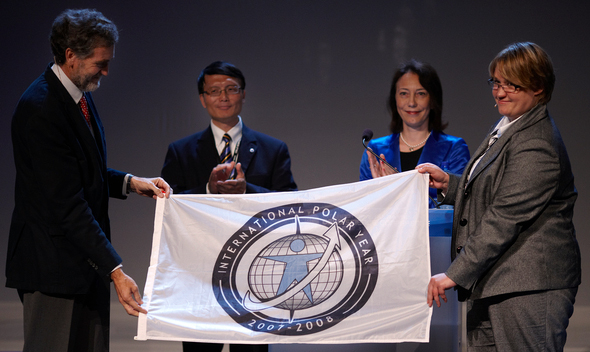New waveIPY conference in Oslo brings fresh energy to polar researchPosted July 2, 2010
[Editor’s note: Lisa Clough is the program manager for the Antarctic Integrated System Science program in the National Science Foundation’s Office of Polar Programs More than 2,300 polar scientists in one place meant this was going to be a conference unlike any other before it, and the International Polar Year (IPY) Oslo Science Conference delivered. From the opening ceremony festivities — complete with ice instruments and crown princes, through the “polar speed dating” and continuous film showings, right up until the last sidebar meeting — the energy was palpable, and the enthusiasm infectious. More on IPY
Sun articles:
IPY Legacies IPY Traverse Changing Course Web sites: United States IPY International IPY An emphasis on the new was present throughout. An extraordinary effort was made during IPY, as well as at the conference, to include teachers and early-career polar scientists. This was evident in just about every talk. This truly was an international meeting. While all the talks were in English — we really are very fortunate to have this be the case — walking down the hall I’d say only one third of the discussions were being held in English. The press releases indicated 60-plus countries were represented, and I believe it. Inclusion was very important. This was the first IPY to specifically include residents of the Arctic in as many aspects of research as possible, and the meeting continued to build on this. The first night reception I attended featured various reindeer foods. Reindeer roast beef — not bad. Reindeer aspic (a savory jelly) — a bit too adventurous for me. The emphasis on traditional knowledge, coupled with the meeting’s presence in Norway, helps explain the “Arctic” flavor. However, the Antarctic was not forgotten. While most sessions and talks made mention of the Arctic, there were key Antarctic sessions, as well as recognition that both polar regions are fundamentally linked to the Earth’s system. A typical day for a meeting participant started early with a 15- to 20-minute walk from a downtown hotel to the train station. Depending on whether or not you caught the express or the local train, it was either an 11- or 30-minute ride out to the conference venue in Lillestrom. Another five-minute walk brought you to the conference venue for the morning session. Then it was on to one of 16 concurrent sessions. Some rooms were next to one another, which made switching betweens sessions a simple endeavor, but other rooms were about a five-minute walk away, so I would typically pick a session and stick with it until the next break. 
Photo Credit: John Petter Reinertsen/Samfoto/IPY-OSC
The closing ceremony of the Oslo Science Conference.
Science posters were up for a day, and the formal poster sessions were accompanied by an adult beverage, if one was interested, which facilitated discussion. With so many students and teachers, the poster sessions were extensive and energetic. In general, the talks and posters were of high quality. But, to be honest, the variation was pretty extreme. On one hand, I saw some excellent talks. On the other, I also saw some presentations that really didn’t provide anything new or exciting to the field of polar science. A few final notes on the out of the ordinary: One of my favorites was the Polar Cinema. On site at Lillestrom there were always films showing, and often the filmmaker was around to provide insight. I also went to the “real” theater downtown one night that was showing two classic movies about Norwegian Roald Amundsen and his historic trip to the South Pole. Definitely something I wouldn’t have been able to do elsewhere, and a great way to refresh my energy for the next day’s talks. Overall, the IPY Oslo meeting was a great use of my time. The scientific results from IPY continue to roll in, and are likely to be better flushed out by the next IPY meeting in 2012 in Montreal. The scientific returns highlighted at IPY Oslo are likely to be seen as coming attractions when we look back on them from the 2012 meeting. What IPY Oslo did — and did very well — was to highlight the ways in which this IPY was immediately new and different from former polar year celebrations. The emphasis on human dimensions, the true flavor of international cooperation, the role of education and outreach, and training of the next generation of polar scientists played and will continue to play in future work, all come to mind. As polar scientists, we must engage the world in our research, and IPY Oslo was a great first step in showing all present how and why we must do that. |



For USAP Participants |
For The Public |
For Researchers and EducatorsContact UsU.S. National Science FoundationOffice of Polar Programs Geosciences Directorate 2415 Eisenhower Avenue, Suite W7100 Alexandria, VA 22314 Sign up for the NSF Office of Polar Programs newsletter and events. Feedback Form |



